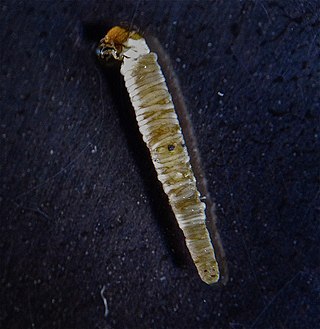
Convolvulaceae, commonly called the bindweeds or morning glories, is a family of about 60 genera and more than 1,650 species. These species are primarily herbaceous vines, but also include trees, shrubs and herbs. The tubers of several species are edible, the best known of which is the sweet potato.

The Pholcidae are a family of araneomorph spiders. The family contains more than 1,800 individual species of pholcids, including those commonly known as cellar spider, daddy long-legs spider, carpenter spider, daddy long-legger, vibrating spider, gyrating spider, long daddy, skull spider, and angel spider. The family, first described by Carl Ludwig Koch in 1850, is divided into 94 genera.

The Algodones Dunes is a large sand dune field, or erg, located in the southeastern portion of the U.S. state of California, near the border with Arizona and the Mexican state of Baja California. The field is approximately 45 miles (72 km) long by 6 miles (9.7 km) wide and extends along a northwest-southeast line that correlates to the prevailing northerly and westerly wind directions. The name "Algodones Dunes" refers to the entire geographic feature, while the administrative designation for that portion managed by the Bureau of Land Management is the Imperial Sand Dunes Recreation Area. In 1966, Imperial Sand Hills was designated as a National Natural Landmark by the National Park Service. The Algodones Dunes are split into many different sections. These sections include Glamis, Gordon's Well, Buttercup, Midway, and Patton's Valley. Although the Arabic-derived Spanish word algodones translates to "cotton plants", the origin of the toponym is unknown.

Petalium is a genus of beetles in the family Ptinidae.
Petalium longulum is a species of beetle in the family Ptinidae.

Didion is a genus of dusky lady beetles in the family Coccinellidae. There are at least three described species in Didion.

Micrasema is a genus of humpless casemaker caddisflies in the family Brachycentridae. There are more than 70 described species in Micrasema.
Mallota bequaerti is a species of syrphid fly in the family Syrphidae.
Aradus acutus is a species of flat bug in the family Aradidae. It is found in North America.
Aradus shermani is a species of flat bug in the family Aradidae. It is found in North America.
Aneurus borealis is a species of flat bug in the family Aradidae. It is found in North America.
Gozmanyina majestus is a species of cosmochthoniid in the family Cosmochthoniidae.
Decarthron is a genus of ant-loving beetles in the family Staphylinidae. There are more than 20 described species in Decarthron.

Chimarra is a genus of little black caddisflies in the family Philopotamidae. There are more than 630 described species in Chimarra.
Aradus intectus is a species of flat bug in the family Aradidae. It is found in North America.
Mezira pacifica is a species of flat bug in the family Aradidae. It is found in North America.
Exochocepheus eremitus is a species of mite in the family Scutoverticidae.

Symphyotrichum boreale is a species of flowering plant of the aster family (Asteraceae) native to North America. Commonly known as rush aster, northern bog aster, and slender white aster, it is a perennial, herbaceous plant that may reach heights of 85 centimetres.
Schistopterum longulum is a species of tephritid or fruit flies in the genus Schistopterum of the family Tephritidae.







